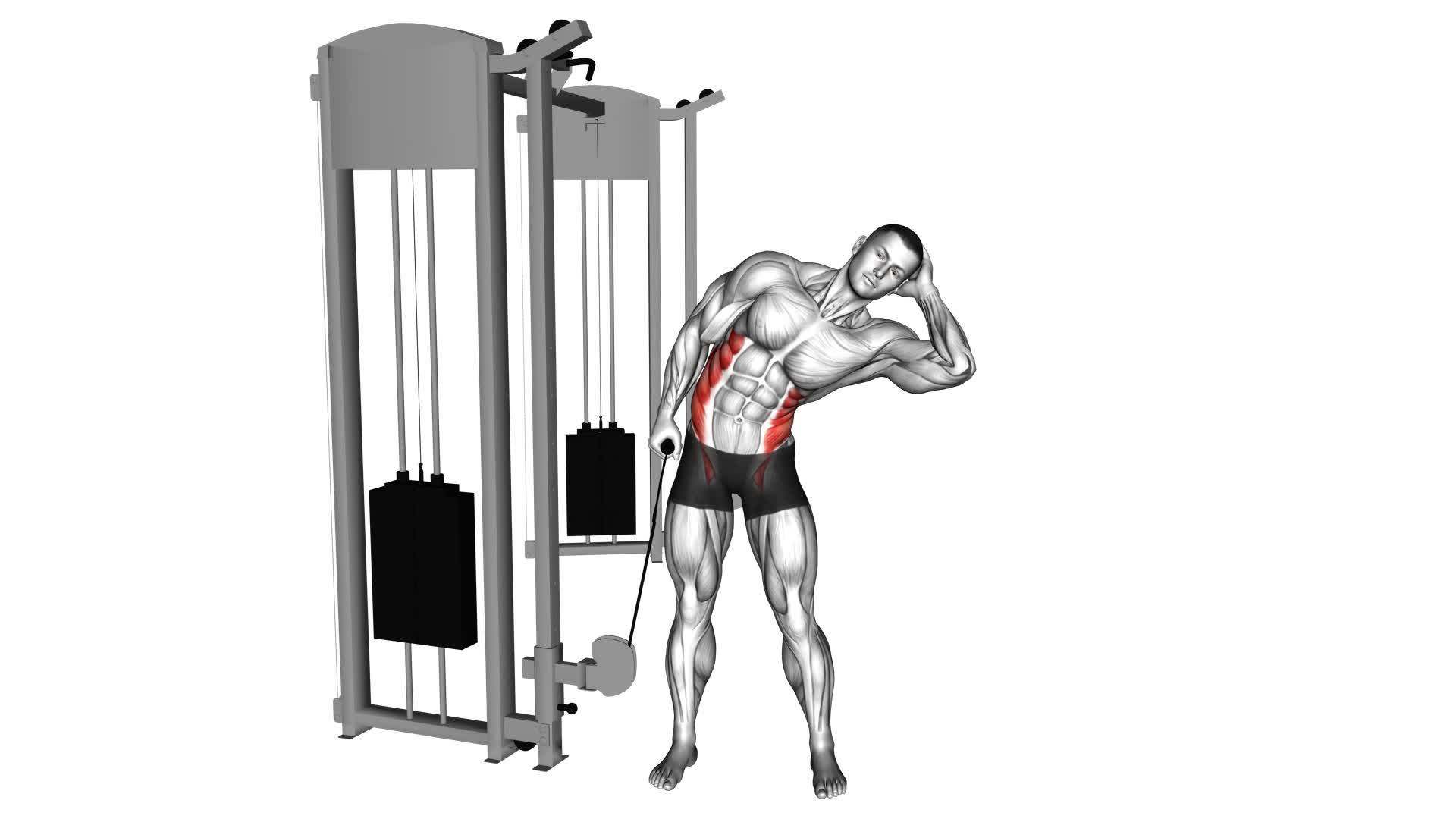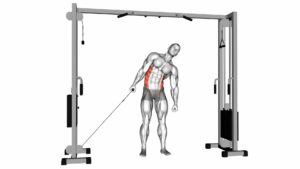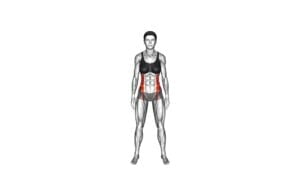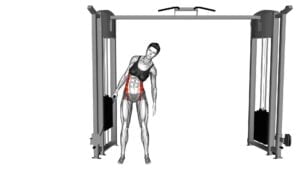Cable Side Bend (VERSION 2) – Video Exercise Guide & Tips

Get ready to strengthen your core and target those obliques with Cable Side Bend (Version 2)!
Watch This Exercise Video
In this video exercise guide, you'll learn all the benefits, proper form, and variations of this effective exercise.
Avoid common mistakes and maximize your results with helpful tips.
Grab your equipment and get ready to feel the burn!
Key Takeaways
- Targets oblique muscles for enhanced core stability and improved posture
- Provides a greater range of motion compared to other variations
- Constant tension from the cable machine engages muscles effectively
- Gradual progression and proper form are important to avoid injuries and muscle imbalances
Benefits of Cable Side Bend (VERSION 2)
To maximize the effectiveness of your workout, it's important to understand the benefits of performing the Cable Side Bend (VERSION 2).
This exercise primarily targets the oblique muscles, which are located on the sides of your abdomen. By strengthening these muscles, you can enhance your core stability and improve your overall posture.
One of the main benefits of the Cable Side Bend (VERSION 2) is that it allows for a greater range of motion compared to other variations of the exercise. The use of a cable machine provides constant tension throughout the movement, which helps to engage the targeted muscles more effectively.
Additionally, this version of the Cable Side Bend offers a versatile workout option. You can adjust the weight and resistance on the cable machine to suit your fitness level and goals. This allows for progression as you become stronger and more proficient in the exercise.
Furthermore, the Cable Side Bend (VERSION 2) helps to improve lateral flexion, which is the ability to bend sideways. This can be beneficial for athletes involved in sports that require twisting or rotating movements, such as golf, tennis, or baseball.
Equipment Needed for Cable Side Bend (VERSION 2)
To perform the Cable Side Bend (Version 2), you'll need some essential equipment. This includes a cable machine with a handle attachment and an appropriate weight stack. It's important to ensure that the cable machine is properly set up and adjusted before starting the exercise.
If you don't have access to a cable machine, there are alternative exercises that can target the same muscle groups.
Essential Equipment for Cable Side Bend (Version 2)
You will need a cable machine and an appropriate weight for performing the Cable Side Bend (Version 2) exercise. The cable machine allows for a smooth and controlled movement, targeting the oblique muscles effectively. Using an appropriate weight ensures that you challenge your muscles without compromising form.
The benefits of Cable Side Bend (Version 2) include strengthening the oblique muscles, improving core stability, and enhancing overall functional fitness. This exercise can also help improve posture and reduce the risk of lower back pain.
To maximize the effectiveness of the Cable Side Bend (Version 2) exercise, it's important to avoid common mistakes. These include using too much weight, which can lead to improper form and potential injury. Another mistake is relying on momentum rather than engaging the targeted muscles. Finally, avoid twisting your torso excessively or leaning forward or backward during the exercise.
Alternatives to Cable Side Bend (Version 2)
Continuing the discussion from the previous subtopic, an alternative to Cable Side Bend (Version 2) that requires the same equipment is the Cable Woodchop.
This exercise targets the obliques and offers a similar range of motion as the Cable Side Bend.
To perform the Cable Woodchop, attach a handle to the cable machine at chest height.
Stand beside the machine with your feet shoulder-width apart and knees slightly bent.
Grab the handle with both hands and pull it diagonally across your body, finishing with your hands above the opposite shoulder.
Focus on engaging your core and rotating your torso as you perform the movement.
Transitioning from alternatives to proper form and technique for Cable Side Bend (Version 2), it's important to ensure proper spine alignment and controlled movements throughout the exercise to maximize its effectiveness.
Proper Form and Technique for Cable Side Bend (VERSION 2)
When performing the Cable Side Bend (VERSION 2), ensure that you maintain proper form and technique throughout the exercise. Here are some tips to help you do it correctly:
- Stand with your feet shoulder-width apart and grasp the cable handle with one hand.
- Keep your back straight and your core engaged throughout the movement.
- Slowly bend to the side, focusing on contracting your oblique muscles.
- Exhale as you bend to the side and inhale as you return to the starting position.
Maintaining proper form and technique is essential to maximize the benefits of lateral flexion. This exercise targets the oblique muscles on the sides of your abdomen, helping to strengthen and tone them. It also improves stability and posture.
Proper breathing techniques are equally important. Exhaling as you bend to the side helps engage your core and deepen the contraction in your obliques. Inhaling as you return to the starting position allows you to reset and prepare for the next repetition.
Now that you know how to perform the Cable Side Bend (VERSION 2) with proper form and technique, let's explore some variations of this exercise.
Variations of Cable Side Bend (VERSION 2)
To add variety to your workout routine, try incorporating different variations of the Cable Side Bend (VERSION 2). By introducing variations into your exercise regimen, you can target different muscle groups and prevent your workouts from becoming monotonous. Here are a few techniques you can try:
- Single-Arm Cable Side Bend: Instead of using both arms simultaneously, perform the exercise with only one arm at a time. This variation adds an element of instability, forcing your core muscles to work harder to maintain balance.
- High Cable Side Bend: Attach the cable handle to the high pulley and stand facing away from the machine. With one hand on your hip, perform the side bend motion, focusing on engaging your obliques and maintaining good posture.
- Kneeling Cable Side Bend: Get down on one knee and attach the cable handle to the low pulley. With one hand on your hip, bend sideways, keeping your core engaged and your back straight.
Remember to start with light weights and gradually increase as you become more comfortable with each variation. Always maintain proper form and breathe throughout the movement.
Common Mistakes to Avoid During Cable Side Bend (VERSION 2)
To perform the Cable Side Bend (Version 2) correctly and avoid common mistakes, it's important to be aware of two major points.
First, using incorrect form can lead to potential dangers and injuries, so make sure to maintain proper alignment and control throughout the exercise.
Second, overloading the weight can put excessive strain on your muscles and joints, so it's crucial to choose a weight that challenges you without compromising your form.
Incorrect Form Dangers
Avoid these common mistakes to ensure proper form and prevent potential dangers while performing the Cable Side Bend (VERSION 2) exercise:
- Twisting the torso: Twisting your torso during the exercise can strain your back and increase the risk of muscle imbalances.
- Using too much weight: Using excessive weight can put excessive stress on your spine and lead to injuries such as herniated discs.
- Neglecting core engagement: Failing to engage your core muscles properly can result in poor stability and increase the risk of falls or strains.
It is crucial to maintain correct form during the Cable Side Bend (VERSION 2) to avoid the dangers of incorrect form and potential injuries. By avoiding these common mistakes, you can protect your body and maximize the effectiveness of this exercise.
Overloading the Weight
Make sure not to load too much weight onto the cable machine when performing the Cable Side Bend (VERSION 2) exercise. Overloading the weight can lead to poor form and increase the risk of injury.
It's important to remember that this exercise is meant to target the oblique muscles, and using excessive weight can shift the focus onto other muscle groups. To avoid overloading, start with a lighter weight and gradually increase as you become more comfortable and confident with the exercise.
Additionally, modifying the exercise by using different attachments or adjusting the pulley height can help vary the intensity and target different areas of the obliques.
Tips for Maximizing the Effectiveness of Cable Side Bend (VERSION 2)
To maximize the effectiveness of your Cable Side Bend (VERSION 2), focus on maintaining proper form and engaging your oblique muscles throughout the exercise. Here are some tips to help you get the most out of this workout:
- Stand upright with your feet shoulder-width apart and your knees slightly bent. This will provide a stable base for the exercise and ensure proper alignment.
- Hold the cable handle with one hand and place the other hand on your hip. This will help you maintain balance and stability during the movement.
- As you bend to the side, exhale and contract your oblique muscles. This will increase the intensity of the exercise and help you achieve better results.
- Remember to keep your core engaged throughout the entire movement. This won't only target your oblique muscles but also strengthen your core as a whole.
- Avoid using momentum to swing the weight. Instead, focus on controlled and deliberate movements to fully engage your muscles.
- Finally, make sure to use an appropriate weight that challenges you without compromising your form. Start with a lighter weight and gradually increase as you become stronger.
By following these tips and maintaining proper form, you can maximize the effectiveness of your Cable Side Bend (VERSION 2) and achieve better results.
Happy exercising!
Frequently Asked Questions
How Many Sets and Repetitions Should I Do for Cable Side Bends?
For cable side bends, the number of sets and repetitions will depend on your fitness level and goals. Generally, it's recommended to start with 2-3 sets of 12-15 repetitions on each side.
This exercise targets your obliques and helps to strengthen and tone your waistline. Cable side bend variations can also be incorporated to add variety and challenge to your workout.
The benefits of cable side bends include improved core stability, enhanced balance, and increased functional strength.
Can Cable Side Bends Help Reduce Belly Fat?
Cable side bends can be a great exercise to target and strengthen your obliques.
However, they may not be the most effective for reducing belly fat.
Crunches, on the other hand, are known for targeting the abdominal muscles and can help reduce belly fat when combined with a healthy diet and overall exercise routine.
If you're a beginner or have limited mobility, cable side bends can be modified by using lighter weights or doing the exercise in a seated position.
Is It Necessary to Use a Cable Machine for This Exercise, or Can I Use Dumbbells Instead?
Yes, you can use dumbbells as an alternative to a cable machine for this exercise. However, using a cable machine offers several benefits.
It provides constant tension throughout the movement, targeting your obliques effectively.
The adjustable weight stack allows you to gradually increase the resistance.
Additionally, the cable machine offers a wider range of motion compared to dumbbells, engaging more muscles.
Can Cable Side Bends Help Improve Posture?
Cable side bends are an effective exercise for improving posture. By targeting the muscles in your core and obliques, cable side bends can help strengthen and stabilize your spine, promoting better alignment.
To reap the benefits, it's important to maintain proper form throughout the exercise. Keep your back straight, engage your abs, and avoid using excessive weight or momentum.
Incorporating cable side bends into your routine can contribute to a stronger and more balanced posture.
Are There Any Alternative Exercises That Target the Same Muscle Groups as Cable Side Bends?
Looking for alternative exercises to target the same muscle groups as cable side bends?
There are several options you can try. Side plank exercises, Russian twists, and dumbbell side bends are all effective alternatives.
These exercises engage the same muscles and help improve core strength and stability.
Incorporating these alternatives into your workout routine can provide variety and help you achieve your fitness goals.
Give them a try and see which one works best for you!
Conclusion
In conclusion, Cable Side Bend (Version 2) is an effective exercise for targeting the obliques and improving core strength.
By utilizing cable resistance, this exercise provides a unique challenge and helps to enhance stability.
It's important to maintain proper form and technique to avoid injury and maximize the effectiveness of the exercise.
By incorporating variations and avoiding common mistakes, you can further enhance your results.
Remember to consult with a fitness professional before attempting any new exercise.

Author
Years ago, the spark of my life’s passion ignited in my mind the moment I stepped into the local gym for the first time. The inaugural bead of perspiration, the initial endeavor, the very first surge of endorphins, and a sense of pride that washed over me post-workout marked the beginning of my deep-seated interest in strength sports, fitness, and sports nutrition. This very curiosity blossomed rapidly into a profound fascination, propelling me to earn a Master’s degree in Physical Education from the Academy of Physical Education in Krakow, followed by a Sports Manager diploma from the Jagiellonian University. My journey of growth led me to gain more specialized qualifications, such as being a certified personal trainer with a focus on sports dietetics, a lifeguard, and an instructor for wellness and corrective gymnastics. Theoretical knowledge paired seamlessly with practical experience, reinforcing my belief that the transformation of individuals under my guidance was also a reflection of my personal growth. This belief holds true even today. Each day, I strive to push the boundaries and explore new realms. These realms gently elevate me to greater heights. The unique combination of passion for my field and the continuous quest for growth fuels my drive to break new ground.







